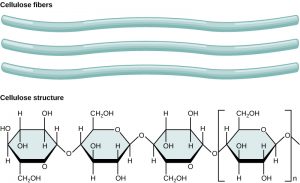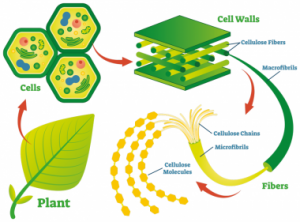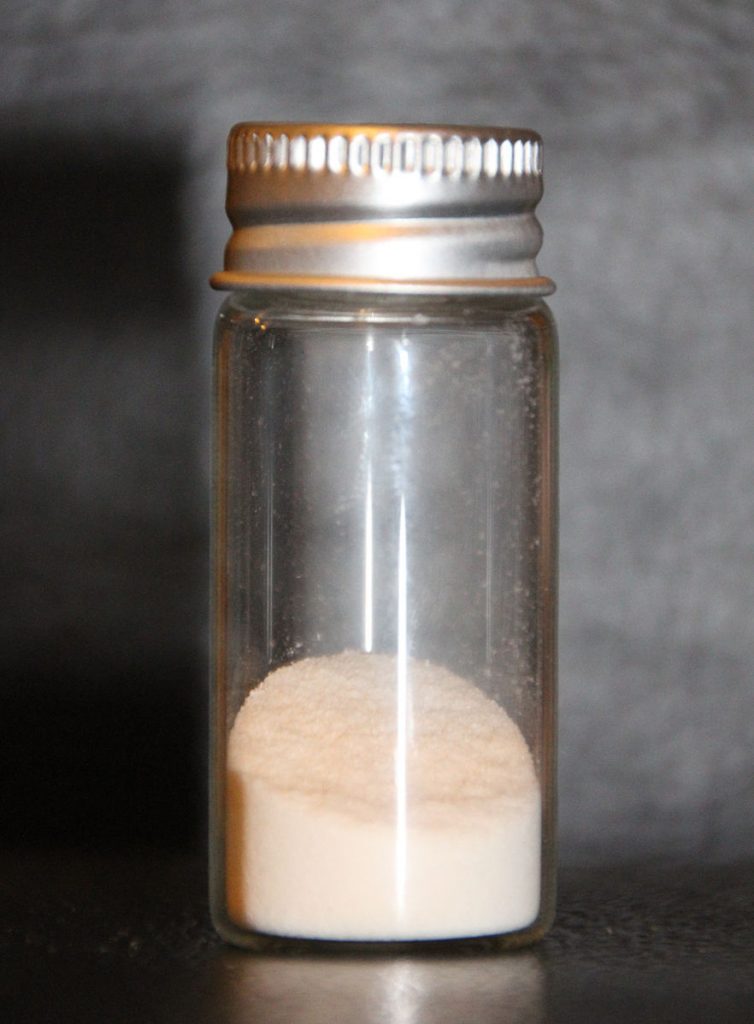Cellulose is the principal substance in the plant cell walls, helping plants to stay stiff and upright. Humans aren’t able to digest it. However, it’s an important element in the diet as fiber. Cellulose is employed in many products: cellophane, food additives, chronic wound treatment, biodegradable packaging.

Image source: https://commons.wikimedia.org/wiki/File:Figure_03_02_07.jpg
What is cellulose?

Image source: https://en.wikipedia.org/wiki/Cellulose
Cellulose is a substance present in the plant cell walls. It is a molecule, consisting of many carbon, hydrogen and oxygen atoms. It is the most abundant organic macromolecule (biopolymer) on Earth. Scientists first examined cellulose in 1833. The chemical structure of cellulose is similar to that of starch, but cellulose is very rigid. This rigidity gives great strength to the plant body and shields the interiors of plant cells. Cellulose is a polysaccharide (or carbohydrate) and has minimal environmental, health and safety risks so it is considered a “green” material.
Structure of cellulose
It is made of at least 500 glucose molecules chain. Many of these polysaccharide chains are organised in parallel orders to form microfibrils. The singular polysaccharide chains are joined together in the microfibrils by hydrogen bonds (strong bonds). The structure of cellulose microfibrils is scientifically called crystalline. This means that the microfibrils have crystal-like properties. The matrix is composed of polysaccharides and proteins. One of the matrix polysaccharides in cell walls is pectin, which becomes a gel-like substance when heated. Pectin is used in the making of jellies and jams. Some types of plants own a secondary cell wall placed over the primary one. The secondary cell wall is composed of a polysaccharide called lignin.

Image source: https://researchoutreach.org/articles/cellulose-nanodefects-key-biofuels-biomaterials-future/
Cellulose forms
Cellulose doesn’t change its molecular structure regardless of the source (wood pulp, cotton, or other vegetable matter). However, based on how the molecules are bonded together and the hydration state, it creates different kinds of cellulose.

Image source: https://commons.wikimedia.org/wiki/File:Sample_of_Carboxymethylcellulose.jpg
- Powdered cellulose is mostly used in food products and for anti-caking applications.
- Cellulose gum or gel, hydrated forms of cellulose, are often used in sauces or other wet food like ice cream and frozen yoghurt.
Cellulose may be present on ingredient lists under the names carboxymethylcellulose, microcrystalline cellulose, or MCC.
.
Applications

by Marco Verch Professional Photographer
Image source: https://www.flickr.com/photos/30478819@N08/50312288401
Cellulose is employed in many products: cellophane, artificial tears, food additives, chronic wound treatment, and filler material in drug tablets. Moreover, cellulose can be processed at industrial scale amounts and at low costs (e.g. wood celluloses are a byproduct of the paper industry, and celluloses are a potential byproduct of the cellulose-to-biofuels business). Even if cellulose can be found in most plant material, the cheapest sources of industrial cellulose are cotton and wood pulp. Cellulose is used as a food supplement for many reasons: as a fibre supplement,as a calorie reducer, and for thickening or emulsifying and anti-caking properties.
Info sources: https://www.bbc.co.uk/bitesize/topics/znyycdm/articles/z2d2gdm
https://engineering.purdue.edu/nanotrees/what_is_cellulose.shtml
https://www.encyclopedia.com/science-and-technology/chemistry/organic-chemistry/cellulose
https://www.thespruceeats.com/what-is-cellulose-1328464
